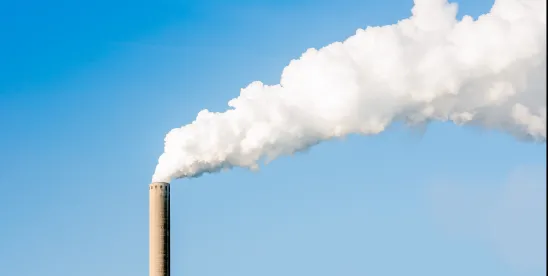The DOE reports that buildings produce more than one-third of the nation’s greenhouse gas (GHG) emissions. As part of the DOE’s efforts to aggressively reduce emissions from buildings by 65% in 2035, the recently released definition provides common minimum standards to assist building owners and operators in achieving a net-zero emissions goal. Now, building owners that wish to refer to their property as “zero emissions” must meet specific benchmarks to accurately promote their environmentally friendly status.
The DOE published a request for information for draft guidance in the Federal Register in January 2024 and released the final definition in June 2024. This came after reviewing feedback on the draft definition from industry, academia, research laboratories, government agencies, and other stakeholders.
The DOE definition evaluates a building’s energy efficiency compared to other similar buildings, assessing its energy efficiency, GHG emissions, and clean energy usage to determine compliance with the DOE definition. The definition is straightforward — requiring only three conditions: energy efficiency, zero on-site emissions from energy use, and powered solely by clean energy — but it marks the DOE’s first attempt at creating workable goals for building owners that wish to reduce carbon output.
The DOE’s definition fits into a larger constellation of local, state, and federal efforts to decarbonize infrastructure, with efforts like New York City’s Local Law 97 designed to reduce emissions by the city’s largest buildings 40% by 2030 and to net zero by 2050.
Purpose of the DOE Definition Is to Guide, Not to Regulate
While this definition is a helpful benchmark, the DOE has clearly stated that the published guidelines are not regulatory standards. The definition does not constitute a rule that entities must follow. Instead, these definitions are intended to articulate common goals for building owners and operators.
Furthermore, the DOE definitions are not a “certification” that building owners can obtain and display. The DOE encourages individual entities using the definition for third-party certification purposes to independently “determine how to document and verify that a particular building meets the definition.”
We outline the definition’s criteria below:
1. Energy Efficiency
Although the simple title could deceive one into thinking this standard is nothing but platitudes, the DOE prescribed actual benchmarks for a building’s “energy efficiency.” An existing building must satisfy one of three criteria to be “energy efficient”:
- Achieve an ENERGY STAR score of 75 or higher. ENERGY STAR is a certification program run by the US Environmental Protection Agency. Efficiency scores issued through the program evaluate a building’s energy, water use, and GHG emissions. A score of 75 indicates that a building’s efficiency is within the top 25% of similar buildings.
- If a building is ineligible for the requisite ENERGY STAR score, the building owner can show a property’s energy efficiency by demonstrating the whole building’s site energy use intensity (EUI) is at least 35% better than the median for similar buildings.
- If a building’s EUI is not 35% above median, the building can still meet this part of the DOE definition if its EUI is less than the EUI standard published by the ANSI/ASHRAE/IES Standard 100. This emissions standard, prepared by the American National Standards Institute (ANSI), applies to all buildings except low-rise residential structures.
New buildings must meet a higher metric to demonstrate their energy efficiency. A new building must satisfy at least of one of three requirements:
- Estimated total energy use at least 10% below the applicable model code prescribed by the DOE (the International Energy Conservation Code for residential buildings and the latest edition of ANSI/ASHRAE/IES Standard 90.1 for commercial buildings).
- Designed to achieve an ENERGY STAR score of 90 or higher.
- Certified to the most recent version of the ENERGY STAR Residential New Construction program or Zero Energy Ready Homes program.
2. Free of On-Site Emissions Caused by Energy Use
A “zero emissions” building, under the DOE definition, must emit zero GHG emissions from energy use. The DOE definition provides a limited exception for emergency backup generators if grid power becomes unavailable, given the challenges associated with replacing generators with other code-compliant alternatives.
3. Powered Solely by Clean Energy
All energy used by the building, whether obtained from on- or off-site sources, must be “clean” — that is, producing zero GHG emissions. Energy sources qualify as clean if they meet the requirements from one of four prescribed clean energy standards, ranging from third-party standards to governmental sustainability requirements.
The DOE definition encourages building owners and operators to maximize their on-site energy sources before turning to off-site sources. Additionally, if a building uses heating and cooling energy from a district system, the district must procure that energy from clean sources.
So, What’s Next?
While the DOE released the definitions as part of its effort to address building-related emissions, it remains to be seen how effective the definitions will be at reducing emissions from the building industry. Nevertheless, the DOE definition provides a standard that certification programs can adopt and that building owners can tangibly incorporate into their new and existing structures. Although the DOE definition purports on its face to provide guidance to property owners and developers, litigation related to climate- and carbon-related issues is on the increase. Developers who make unverifiable marketing or advertising-related “net zero” claims face the possibility of becoming enmeshed in “greenwashing”-style litigation involving claims of deceptive trade practices.



 />i
/>i

